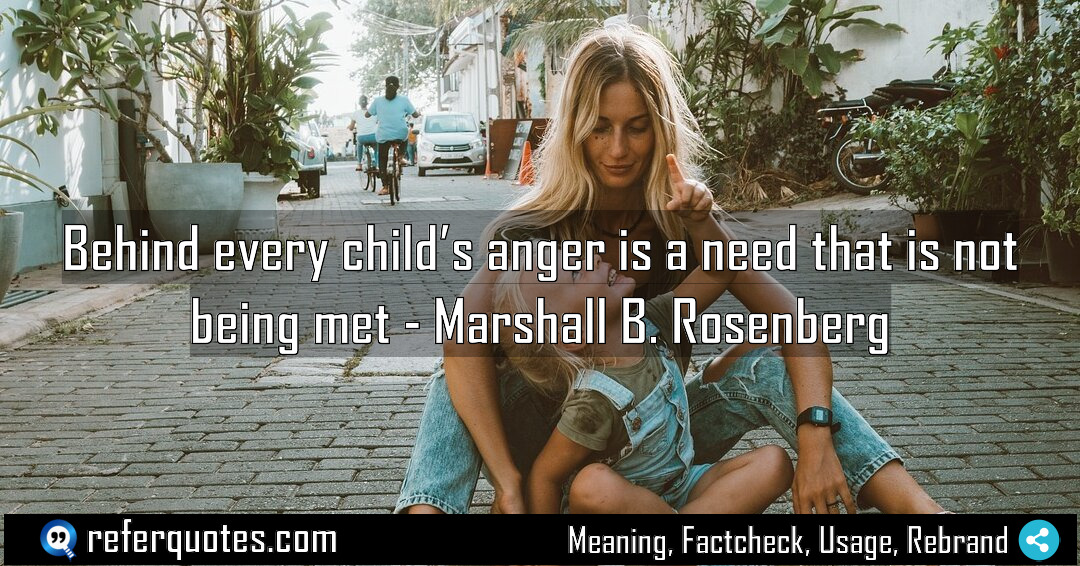
Behind every child’s anger is a need… it sounds simple, right? But this one idea completely reframes how we see tantrums and teenage slamming doors. It’s not about defiance; it’s about an unmet request for help, connection, or understanding.
Share Image Quote:
Table of Contents
Meaning
At its core, this quote teaches us that a child’s anger is not the problem itself, but a symptom of a deeper, unmet need.
Explanation
Let me break it down for you. For years, I used to see a kid acting out and think, “Okay, how do I stop this behavior?” That’s a surface-level fix. What Rosenberg is saying is that the anger is just the signal. It’s the smoke, not the fire. The real work is to look behind the yelling or the sulking and ask, “What is the need here that they cannot articulate?” Maybe it’s a need for autonomy, for respect, for a hug, for feeling heard. When you start to see it that way, your entire approach shifts from punishment to compassionate detective work.
Quote Summary
Reading Level70
Aesthetic Score85
Origin & Factcheck
This wisdom comes directly from Marshall B. Rosenberg’s 2005 book, Raising Children Compassionately. It’s a cornerstone of his Nonviolent Communication (NVC) framework. You sometimes see similar sentiments floating around, but this specific phrasing is Rosenberg’s. He developed these ideas over decades, starting his work in the 1960s.
Attribution Summary
Where is this quotation located?
| Quotation | Behind every child’s anger is a need that is not being met |
| Book Details | Publication Year/Date: 2004; ISBN/Unique Identifier: 9781892005140; Last edition: PuddleDancer Press, 1st Edition, 48 pages. |
| Where is it? | Chapter: Understanding Emotional Reactions, Approximate page from 2005 edition |
Context
In the book, this isn’t just a one-off line. It’s the entire foundation. Rosenberg places this idea within the framework of moving away from a language of demands, blame, and judgment (“Why are you so difficult?”) and towards a language of needs and requests. The goal is connection, not control.
Usage Examples
So how do you actually use this? It’s a game-changer for so many.
- For Parents: Your toddler is having a meltdown in the supermarket. Instead of “Stop crying!”, you might get down on their level and guess, “You seem really upset. Are you feeling tired and just need to go home?” You’re addressing the need (rest), not just the behavior (screaming).
- For Teachers: A student is defiant and rude in class. The old way was a detention. The NVC way is to pull them aside later and say, “I noticed you got really angry when I gave the assignment. Are you feeling overwhelmed and need some help getting started?” You’re looking for the need for support or clarity.
- For Coaches and Mentors: Honestly, it works with adults too. Someone on your team is frustrated and snapping. The need might be for recognition, for more resources, or for their ideas to be heard.
To whom it appeals?
Share This Quote Image & Motivate
Motivation Score80
Popularity Score72
Shareability Score76
Common Questions
Question: So does this mean I should just let my child be angry and never set boundaries?
Answer: Not at all. This is the biggest misconception. The idea is to first connect with the unmet need with empathy. Once the child feels understood and the underlying need is addressed, you can then collaboratively set a boundary around the behavior. “I understand you’re angry because you want to keep playing, and it’s hard to stop. The need for fun is important. And, it’s dinnertime now. How can we make stopping easier?”
Question: What if I can’t figure out what the need is?
Answer: That’s totally normal. The power isn’t in being a mind-reader; it’s in the attempt. Simply making the shift to *look* for a need changes the dynamic. You can even say, “I want to understand what’s going on. I’m guessing you might be feeling… [frustrated, lonely, scared]… is that close?” The effort to connect is what matters most.
Question: Is this just permissive parenting?
Answer: Absolutely not. Permissive parenting ignores the behavior *and* the need. This is authoritative parenting—it values both the child’s emotional world (the need) and the parent’s responsibility to guide (the boundary). It’s firm on the values, but soft on the people.
Similar Quotes
Every time we choose empathy over anger, we’re actually modeling a profound kind of strength for our kids. It’s a counterintuitive truth that flips our whole understanding of power on…
You know, when Marshall Rosenberg said “Children are never the problem,” he was pointing a finger right back at us. It’s a game-changer that forces you to stop blaming the…
Every conflict with a child is an opportunity… to connect, not to win. It’s a game-changing mindset shift for parents that transforms power struggles into moments of genuine relationship-building. Table…
You know, when Marshall Rosenberg said “Every child deserves to grow up in an atmosphere of understanding,” he was really onto something. It’s a game-changer for how we connect with…
You know, when Marshall Rosenberg said, “It is not our job to make children behave,” he was really flipping the script on traditional parenting. It’s not about control, but about…
